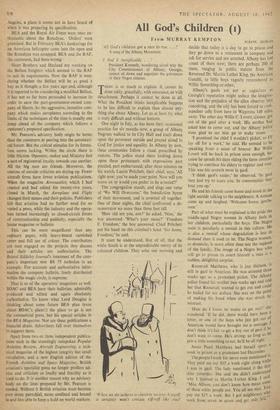Closed Circuit
By OLIVER STEWART
AIXIETIES about the cancellation of orders for the VC-10 air-liner, the BOAC-Cunard Atlantic merger, M. Georges Hereil's resigna- t:on and the Anglo-French supersonic project, redundancies in the British industry and the threat that Short Brothers may close can nearly
11 be referred to the drawing in and circum- scribing of British aviation. Because it has changed from being centrifugal, competitive and expansionist and become centripetal, co-opera- tive and confined, it needs, I believe, the ad- 1,isory body proposed in a paper read before the Royal Aeronautical Society in May by Mr. J. D. Pearson, chief executive and deputy chair- man of Rolls-Royce.
Instead of bursting out in all directions, broad- casting every kind of aeroplane as it did when it was very young, the aircraft industry now works within a closed, national community. Formerly a score of makers served a score of customers producing a score of different kinds of aircraft with four Ministries occasionally in- tervening. Success was then a statistical prob- ability. Now there are in Britain three makers, three customers, three different aircraft types and one Ministry. Without independent, in- formed guidance success in such circumstances becomes no more than an even chance.
Let the procedural change be expounded by comparison with the motor-car industry. There production precedes and initiates orders. But in British aviation orders now precede and initiate rrod uction.
The VC-10, which made its first flight recently, is a splendid piece of engineering, an example of all that is good in design and manufacture. It was ordered by BOAC with Ministry approval in 1958 about eight months after an `intention' to order had been expressed. It is an example of the present form of co- operative effort; operator, Ministry and manu- facturer all working together. Theoretically all is well. The maker gets a guaranteed sale before starting production, the customer gets the air- craft he asks for and the Ministry supervises and dispenses encouragement from public funds.
Unfortunately when he tries to forecast what
he will want five or six years ahead, the customer is not always right. He is nearly always wrong. And between specification and production he changes his mind. BOAC once thought it wanted the V 1000 -jet air-liner, but later preferred Boeings. By May, 1961, BOAC was becoming restive about the VC-10. Today it is even more restive and is casting longing glances towards an aircraft which was built without benefit of BOAC or of the Ministry of Aviation, by Boeing.
Apart from its good airfield performance the
VC-10 is now suspected of having little that the new Boeings will not have. Airfield per- formance is of the highest importance for Com- monwealth routes; but who bothers about the Commonwealth? BOAC is thinking about Los Angeles, a place it seems not to have heard of when it was preparing its specification.
BEA and the Royal Air Force were once en- thusiastic about the Rotodyne. 'Orders' were promised. But in February BEA's hankerings for an American helicopter came into the open and The Rotodyne was scrapped. BEA and the RAF, the customers, had been wrong.
Short Brothers and Harland are working on the Belfast freighter which seemed to the RAF to suit its requirements. Now the RAF is won- dering whether the Belfast will be as good a buy as it thought a few years ago and, although it is reported to be considering a modified Belfast, it has not so far been persuaded to increase its order to save the part-government-owned com- pany of Shorts. So the aggressive, inventive com- pany which makes aeroplanes according to the limits of the techniques of the time is usually one jump ahead of the company which follows a customer's prepared specification.
Mr. Pearson's advisory body might be better than the customers at peering into the aeronauti- cal future. But the critical stimulus for its forma- tion seems lacking. Within the circle there is little friction. Operator, maker and Ministry feel a sort of regimental loyalty towards one another. All the big men are friends. Moreover, the sources of outside criticism are drying up. Fewer aircraft firms have fewer aviation publications. When the magazine Aeronautics, which I had created and had edited for twenty-two years, closed in March, the Aeroplane and Flight changed their names and their policies. Publishers felt that aviation had no further need for so varied a press, white the industry and the opera- tors turned increasingly to closed-circuit forms of communication and publicity, especially the house magazine or bulletin.
This can be more magnificent than any ordinary paper, with heavy-board varnished cover and full use of colour. The contributors are men engaged on the projects they discuss and their articles are authoritative. The Bristol Sidderey Journal's treatment of the com- pany's important new BS 75 turbofan is an example. For accurate and authoritative infor- mation the company bulletin, freely distributed 1.
within the magic circle, is supreme.
That is so of the operators' magazines as well BOAC and BEA have their bulletins, admirably produced and edited and again absolutely authoritative. To know what Lord Douglas is thinking about some future BEA plan (even about BOAC's plans!) the place to go is not the commercial press, but his special articles in the BEA Magazine. Nor are these publications a financial drain. Advertisers fall over themselves to support them.
Apart from two or three independent publica- tions such as the stunningly outspoken Popular Aviation Review, Aircraft Engineering, a tech- nical magazine of the highest integrity but small circulation, and a new English edition of the French Aviation and Space Magazine, British aviation's specialist press no bringer proffers ad- vice and criticism as loudly and forcibly as it tsed to do. It is another reason why an advisory body on the lines proposed by Mr. Pearson is needed. Without it British aviation must become ever more parochial, more confined and bound in and less able to keep a hold on world markets.































 Previous page
Previous page